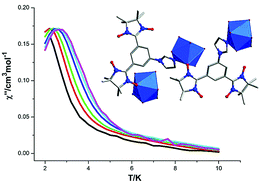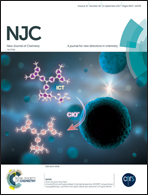Functionalized nitronyl nitroxide biradical bridged one-dimensional lanthanide chains: slow magnetic relaxation in the Tb and Dy analogues†
Abstract
The functionalized nitronyl nitroxide biradical bridged one-dimensional lanthanide chains [Ln(tfa)3(NITPhImbis)]·CH2Cl2 (LnIII = Gd 1, Tb 2, Dy 3 and Nd 4; tfa = trifluoroacetylacetonate; NITPhImbis = 1-imidazole-3,5-bis(1′-oxyl-3′-oxido-4′,4′,5′,5′-tetramethyl-4,5-hydro-1H-imidazol-2-yl)benzene) have been prepared and characterized. Single crystal X-ray diffraction analyses reveal that complexes 1–4 possess a one-dimensional chain structure in which each nitronyl nitroxide biradical acts as a bridging ligand to link two different lanthanide ions via one of the NO groups and the imidazole ring of the biradical ligand to form a one-dimensional chain with a ‘head-to-tail’ structural motif. DC magnetic studies show that the magnetic interaction between the Gd atom and the coordinated NO group is ferromagnetic while the intramolecular magnetic coupling between two monoradicals is antiferromagnetic. Moreover, the spin dynamics indicates the presence of slow magnetic relaxation for Tb and Dy analogues, which could be attributed to the Dy/Tb-bis(nitronyl nitroxide) moieties. Thus, complexes Tb and Dy behave like chains of single-molecule magnets (SMMs).



 Please wait while we load your content...
Please wait while we load your content...